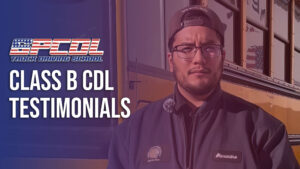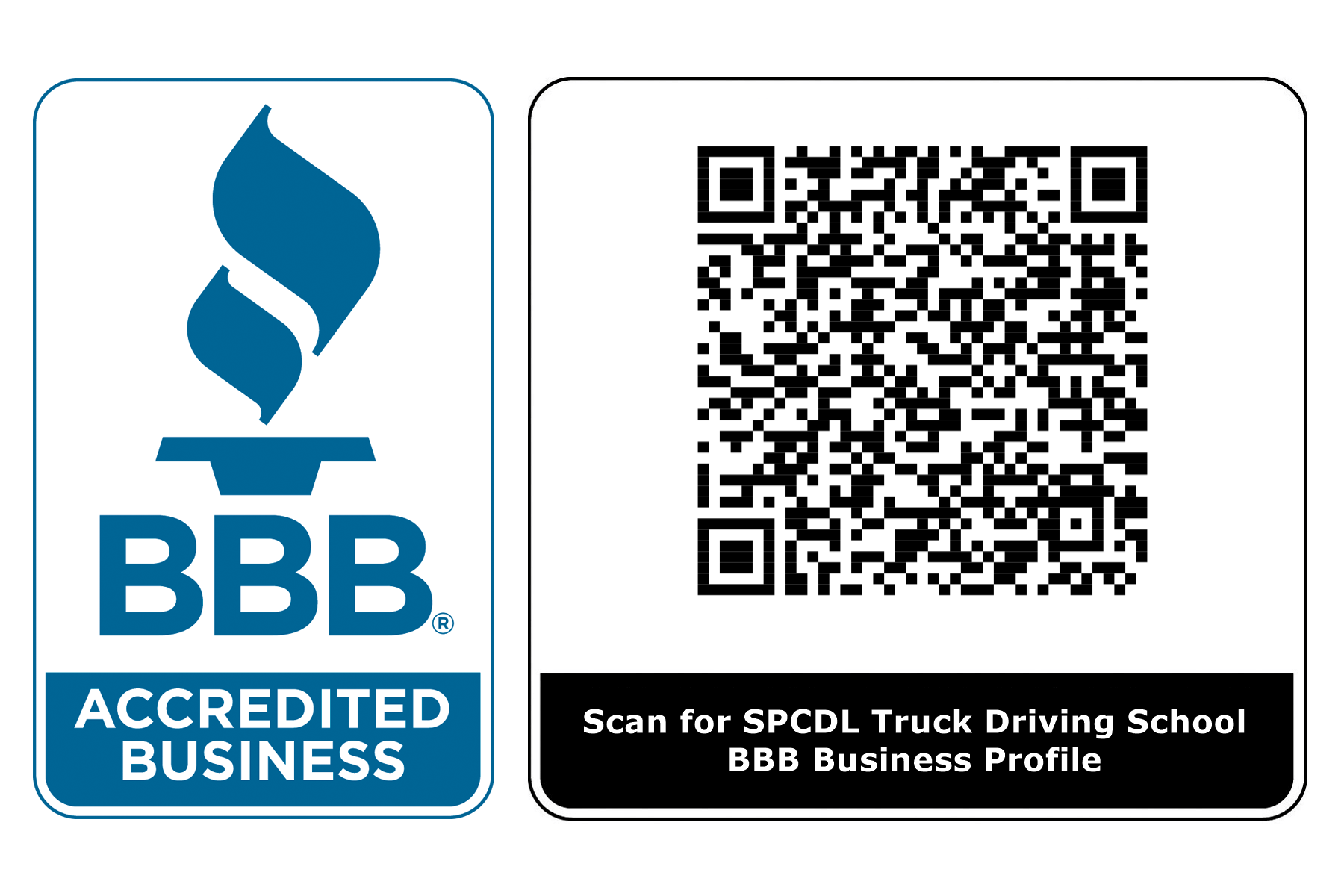Class B CDL Training
Class B CDL Training
Driving Our Students to Success
At SPCDL Truck Driving School, we’re dedicated to helping our students become skilled, confident commercial drivers. Our Class B CDL training program is designed to equip you with the knowledge and hands-on experience you need to obtain your Class B license and jumpstart a career in the commercial driving industry.
Whether you're aiming to drive buses, large trucks, or other commercial vehicles, our training program provides the tools you need to succeed.
We offer nationwide online training for anyone in the USA who would like to learn through our academic program during a time that’s most convenient with your schedule.
SPCDL proudly serves students in person across San Bernardino, Riverside, Orange, Los Angeles, and San Diego Counties in California. With our flexible payment options and a 10% discount for military, veterans, and first responders, we ensure that cost is not a barrier to your success.
The SPCDL Advantage
SPCDL is committed to providing superior CDL training experience. Here’s why our program is the best choice for your Class B CDL training:
- Experienced Instructors: Learn from instructors with decades of experience in commercial driving, ensuring you receive the best training.
- No Shared Trucks: You’ll never share a truck or trainer with other students, ensuring maximum practice time behind the wheel.
- Small Trucks, Easy to Maneuver: Our vehicles are designed for easier driving, making it simpler to pass your road test.
- Support Throughout the Entire Process: From the first day of training to the day of your DMV test, SPCDL is with you every step of the way.
What is a Class B CDL?
A Class B Commercial Driver’s License (CDL) permits you to operate vehicles with a gross vehicle weight rating (GVWR) of 26,001 pounds or more, where the trailer being towed does not exceed 10,000 pounds. This license opens opportunities to drive a variety of commercial vehicles, including:
- Box trucks
- Large buses (city buses, school buses)
- Dump trucks
- Delivery trucks
- Garbage trucks
- Cement trucks
- Tractor-trailers (with a small trailer)
Holding a Class B CDL allows you to operate vehicles that are vital in many industries, providing a solid foundation for a stable, rewarding career.
Why Choose SPCDL for Your Class B CDL Training?
PLEASE NOTE: TRAINING HOURS FOR CURRENT CDL HOLDERS ADDING A PASSENGER ENDORSEMENT
Current CDL holders and Class C CDLs that are adding a Passenger Endorsement have no minimum number of training hours required.
Our program provides online theory training and (4) hours of 1 on 1 training. New Class A or Class B CDLs are required to do a minimum of 15 hours of training in California.
Total Program with in-person instructor is 180 Hours: SPCDL offers a well-rounded training experience, including:
160 hours of online learning combined with 16-20 hours of in-person driving practice with certified instructors.
Online Multimedia Training: Our online modules cover every aspect of your CDL training, from safety regulations to road laws, allowing you to learn at your own pace.
One-on-One Hands-On Training: Get personalized, one-on-one driving experience. With SPCDL, there’s no sharing trucks or trainers. You get full access to a vehicle and an experienced instructor for maximum practice time.
DMV Support: On the day of your CDL test, SPCDL meets you at the DMV with our truck, helping you navigate the entire testing process with confidence.
Flexible Payment Options & Discounts
We understand the importance of affordable education, which is why SPCDL offers flexible payment plans tailored to your financial needs.
Military personnel, veterans, and first responders also benefit from a 10% discount on the total tuition cost, making it even easier to get started.
Class B CDL Training Breakdown
Our Class B CDL program ensures that you’re well-prepared to pass both the written and road tests. Here’s a breakdown of what you’ll learn:
- Online Training (160 Hours):
- Orientation and Basics: Introduction to commercial driving, vehicle operation, and regulatory standards.
- Pre- and Post-Trip Inspections: Learn how to conduct thorough inspections to ensure the vehicle is safe and compliant before and after every trip.
- Vehicle Control and Operations: Master techniques for controlling large commercial vehicles in various traffic and road conditions.
- Safety and Visual Awareness: Understand how to maintain situational awareness, anticipate hazards, and apply defensive driving techniques.
- Speed and Space Management: Learn how to properly manage your speed and the space around your vehicle to avoid accidents.
- Driving in Special Conditions: Receive training on how to drive in difficult conditions such as rain, fog, and snow.
- Hazard and Skid Control: Gain the skills to prevent and recover from skids and other hazardous driving situations.
- Inspections and Maintenance: Learn how to identify vehicle defects and handle routine maintenance tasks.
- Hours of Service: Understand the federal and state regulations for managing driving hours to avoid fatigue and ensure safety.
- Cargo and Compliance: Learn how to safely load, secure, and transport cargo according to federal regulations.
- In-Person Training (16-20 Hours):
- Vehicle Operation: Drive larger commercial vehicles under real-world conditions, mastering skills like turning, backing up, and parking.
- Pre-trip Inspections: Perform pre-trip inspections on your own, ensuring your understanding of all necessary safety protocols.
- Test Preparation: Practice key maneuvers required for the road test, including managing intersections, lane changes, and navigating tight spaces.
Class B CDL with Hazmat Training – Key Features
- Single Vehicle License: A Class B CDL allows you to operate single vehicles with a gross vehicle weight rating (GVWR) of 26,001 pounds or more, with trailers under 10,000 pounds.
Hazmat Endorsement (H)
- Age Requirement: You must be 21 years old to get a Hazmat Endorsement.
- Transport Hazardous Materials: With a Hazmat Endorsement, you are qualified to transport dangerous goods such as chemicals, fuels, and other hazardous materials in a single vehicle.
- TSA Background Check: Completion of a TSA background check and submission of fingerprints is mandatory.
- Written Test: You must pass a Hazmat-specific written test that covers the handling, storage, and transportation of hazardous materials.
- Federal Compliance: Learn essential safety protocols and FMCSA and DOT regulations to ensure compliance when transporting hazardous goods.
Training Includes:
- Vehicle Inspections: Emphasis on pre-trip and post-trip inspections for vehicles transporting hazardous materials to ensure compliance and safety.
- Hazmat Compliance: Detailed instruction on federal and state regulations regarding the safe transport of hazardous materials.
- Emergency Procedures: Learn how to manage emergencies such as spills, leaks, or accidents involving hazardous materials, ensuring the safety of the public and yourself.
- Placard Usage: Instruction on the proper use of placards to identify the type of hazardous materials being transported.
- Increased Earning Potential: Drivers with a Class B CDL and Hazmat endorsement often have access to higher-paying positions due to the specialized nature of hazardous materials transport.
- Job Opportunities: A Hazmat endorsement on a Class B CDL allows you to work in industries such as:
- Fuel and oil delivery
- Chemical transportation
- Local hazardous waste transport
Added Responsibility: With the Hazmat endorsement comes the need for strict adherence to safety standards and detailed knowledge of how to manage and transport hazardous materials.
By obtaining a Class B CDL with Hazmat training, you gain access to more specialized job opportunities and higher-paying roles. This endorsement demonstrates your ability to handle potentially dangerous goods safely, increasing your value as a commercial driver.
California and Federal CDL Requirements
To operate a commercial vehicle, you must meet both federal and California state requirements. SPCDL’s program is fully compliant with these regulations, ensuring you’re prepared for every step of the licensing process.
- Federal CDL Requirements:
- Drivers must be at least 18 years old for intrastate driving and 21 years old for interstate driving.
- A DOT medical exam is required to ensure drivers are fit to operate commercial vehicles.
- Compliance with FMCSA (Federal Motor Carrier Safety Administration) regulations, including Hours of Service rules, which limit how long a driver can operate a vehicle without rest.
- California CDL Requirements:
- Pass both the California CDL written exam and road skills test.
- California-specific regulations regarding vehicle inspections and safety protocols.
- Understanding California’s emissions and environmental regulations for commercial vehicles.
Comparison: Class A, Class B, Class C, and Passenger Endorsements
When deciding which commercial license to pursue, it’s important to understand the differences between Class A, Class B, and Class C licenses, as well as the Passenger Endorsement:
- Class A CDL:
- Permits operation of large vehicles with a GVWR of 26,001 pounds or more and trailers exceeding 10,000 pounds.
- Common vehicles: Tractor-trailers, flatbeds, livestock carriers.
- Class B CDL:
- Permits operation of large vehicles with a GVWR of 26,001 pounds or more, but trailers must not exceed 10,000 pounds.
- Common vehicles: Buses, dump trucks, delivery trucks, garbage trucks.
- Class C CDL:
- For vehicles designed to transport 16 or more passengers or hazardous materials.
- Common vehicles: Small hazmat trucks, passenger vans.
- Passenger Endorsement:
- Required to operate vehicles designed to transport 16 or more passengers (including the driver).
- Common vehicles: City buses, school buses, tour buses.
Why Get a Class B CDL?
Obtaining a Class B CDL opens a range of career possibilities in sectors like transportation, construction, waste management, and logistics. Key benefits include:
- Job Opportunities: With a Class B CDL, you can work in a variety of industries, driving vehicles such as city buses, delivery trucks, and construction vehicles.
- Competitive Salaries: Jobs requiring a Class B CDL often offer stable, well-paying career options.
- Job Stability: The demand for commercial drivers continues to grow, offering reliable employment.
If you’re working toward obtaining your Class B CDL, understanding and addressing license restrictions is crucial. SPCDL Truck Driving School offers expert training on How to Remove a Restriction on a CDL in California, ensuring you meet the state’s requirements and open doors to more driving opportunities. Don’t let restrictions hold you back—our personalized approach makes all the difference.
Start Your Commercial Driving Career Today
SPCDL Truck Driving School offers an affordable, flexible, and comprehensive way to get your Class B CDL. Our expert instructors, tailored training, and personalized approach will help you drive your way to success.
- Sign Up Today: Call Us to Get Started or fill out the form through our website and we will get back to you.
- Flexible Payment Options: Customize your payment plan to suit your financial needs.
- Discounts for Military, Veterans & First Responders: Enjoy 10% off your training if you qualify.
Call Now(909) 353-9897 To Get Started or Fill Out the SPCDL's form through our website anytime and learn how to get a CDL now.
Frequently Asked Questions
CDL Class B License
Earning your Class B certification opens the door to higher salaries and numerous advancement opportunities. Our graduates are often in line for jobs with an average salary of at least $55,990. Salaries differ per state and employer. At SPCDL, we provide top-notch CDL Class B training to help our graduates have the opportunity to get the best jobs.
At SPCDL Truck Driving School, we make obtaining your CDL license and starting a rewarding career simpler than you ever imagined. Don't wait—give us a call now to begin the career you've been dreaming of!
© Copyright 2025 SPCDL Truck Driving School - All Rights Reserved. Privacy -Terms of Service - Disclaimer - Sitemap
Web Development and Marketing by Digital Media Cube




